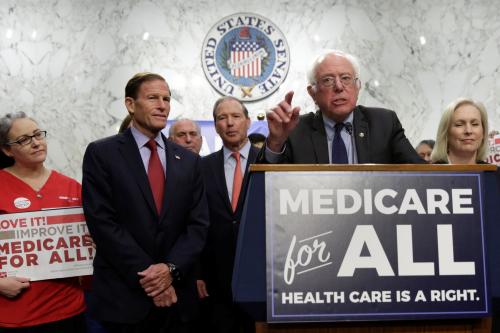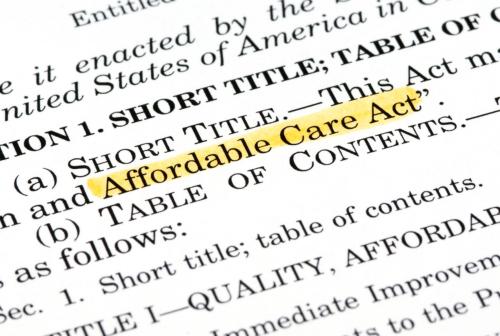Led by presidential candidate Bernie Sanders, one-time supporters of ‘single-payer’ health reform are rekindling their romance with a health reform idea that was, is, and will remain a dream. Single-payer health reform is a dream because, as the old joke goes, ‘you can’t get there from here.
Let’s be clear: opposing a proposal only because one believes it cannot be passed is usually a dodge. One should judge the merits. Strong leaders prove their skill by persuading people to embrace their visions. But single-payer is different. It is radical in a way that no legislation has ever been in the United States.
Not so, you may be thinking. Remember such transformative laws as the Social Security Act, Medicare, the Homestead Act, and the Interstate Highway Act. And, yes, remember the Affordable Care Act. Those and many other inspired legislative acts seemed revolutionary enough at the time. But none really was. None overturned entrenched and valued contractual and legislative arrangements. None reshuffled trillions—or in less inflated days, billions—of dollars devoted to the same general purpose as the new legislation. All either extended services previously available to only a few, or created wholly new arrangements.
To understand the difference between those past achievements and the idea of replacing current health insurance arrangements with a single-payer system, compare the Affordable Care Act with Sanders’ single-payer proposal.
Criticized by some for alleged radicalism, the ACA is actually stunningly incremental. Most of the ACA’s expanded coverage comes through extension of Medicaid, an existing public program that serves more than 60 million people. The rest comes through purchase of private insurance in “exchanges,” which embody the conservative ideal of a market that promotes competition among private vendors, or through regulations that extended the ability of adult offspring to remain covered under parental plans. The ACA minimally altered insurance coverage for the 170 million people covered through employment-based health insurance. The ACA added a few small benefits to Medicare but left it otherwise untouched. It left unaltered the tax breaks that support group insurance coverage for most working age Americans and their families. It also left alone the military health programs serving 14 million people. Private nonprofit and for-profit hospitals, other vendors, and privately employed professionals continue to deliver most care.
In contrast, Senator Sanders’ plan, like the earlier proposal sponsored by Representative John Conyers (D-Michigan) which Sanders co-sponsored, would scrap all of those arrangements. Instead, people would simply go to the medical care provider of their choice and bills would be paid from a national trust fund. That sounds simple and attractive, but it raises vexatious questions.
- How much would it cost the federal government? Where would the money to cover the costs come from?
- What would happen to the $700 billion that employers now spend on health insurance?
- How would the $600 billion a year reductions in total health spending that Sanders says his plan would generate come from?
- What would happen to special facilities for veterans and families of members of the armed services?
Sanders has answers for some of these questions, but not for others. Both the answers and non-answers show why single payer is unlike past major social legislation.
The answer to the question of how much single payer would cost the federal government is simple: $4.1 trillion a year, or $1.4 trillion more than the federal government now spends on programs that the Sanders plan would replace. The money would come from new taxes. Half the added revenue would come from doubling the payroll tax that employers now pay for Social Security. This tax approximates what employers now collectively spend on health insurance for their employees … if they provide health insurance. But many don’t. Some employers would face large tax increases. Others would reap windfall gains.
The cost question is particularly knotty, as Sanders assumes a 20 percent cut in spending averaged over ten years, even as roughly 30 million currently uninsured people would gain coverage. Those savings, even if actually realized, would start slowly, which means cuts of 30 percent or more by Year 10. Where would they come from? Savings from reduced red-tape associated with individual insurance would cover a small fraction of this target. The major source would have to be fewer services or reduced prices. Who would determine which of the services physicians regard as desirable—and patients have come to expect—are no longer ‘needed’? How would those be achieved without massive bankruptcies among hospitals, as columnist Ezra Klein has suggested, and would follow such spending cuts? What would be the reaction to the prospect of drastic cuts in salaries of health care personnel—would we have a shortage of doctors and nurses? Would patients tolerate a reduction in services? If people thought that services under the Sanders plan were inadequate, would they be allowed to ‘top up’ with private insurance? If so, what happens to simplicity? If not, why not?
Let me be clear: we know that high quality health care can be delivered at much lower cost than is the U.S. norm. We know because other countries do it. In fact, some of them have plans not unlike the one Senator Sanders is proposing. We know that single-payer mechanisms work in some countries. But those systems evolved over decades, based on gradual and incremental change from what existed before. That is the way that public policy is made in democracies. Radical change may occur after a catastrophic economic collapse or a major war. But in normal times, democracies do not tolerate radical discontinuity. If you doubt me, consider the tumult precipitated by the really quite conservative Affordable Care Act.
Editor’s note: This piece originally appeared in Newsweek.









Commentary
Op-edThe impossible (pipe) dream—single-payer health reform
January 26, 2016